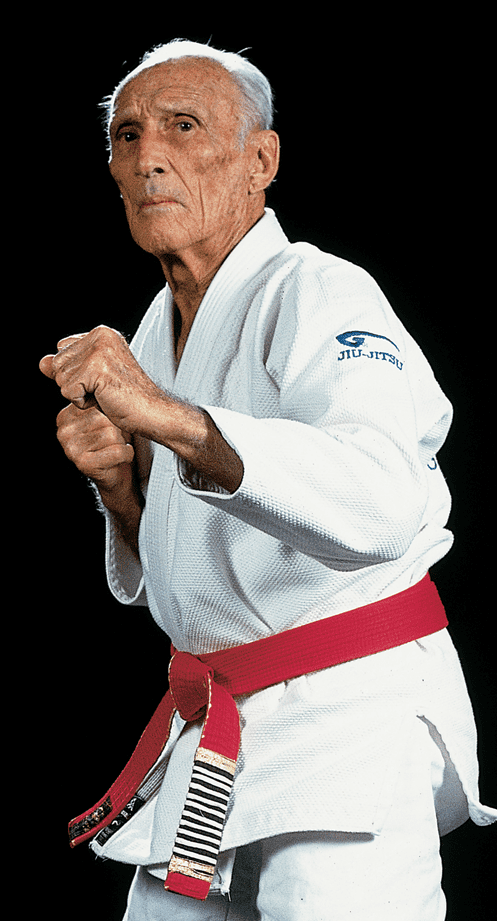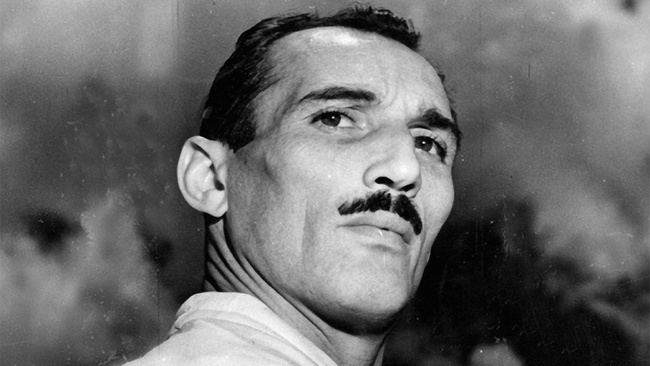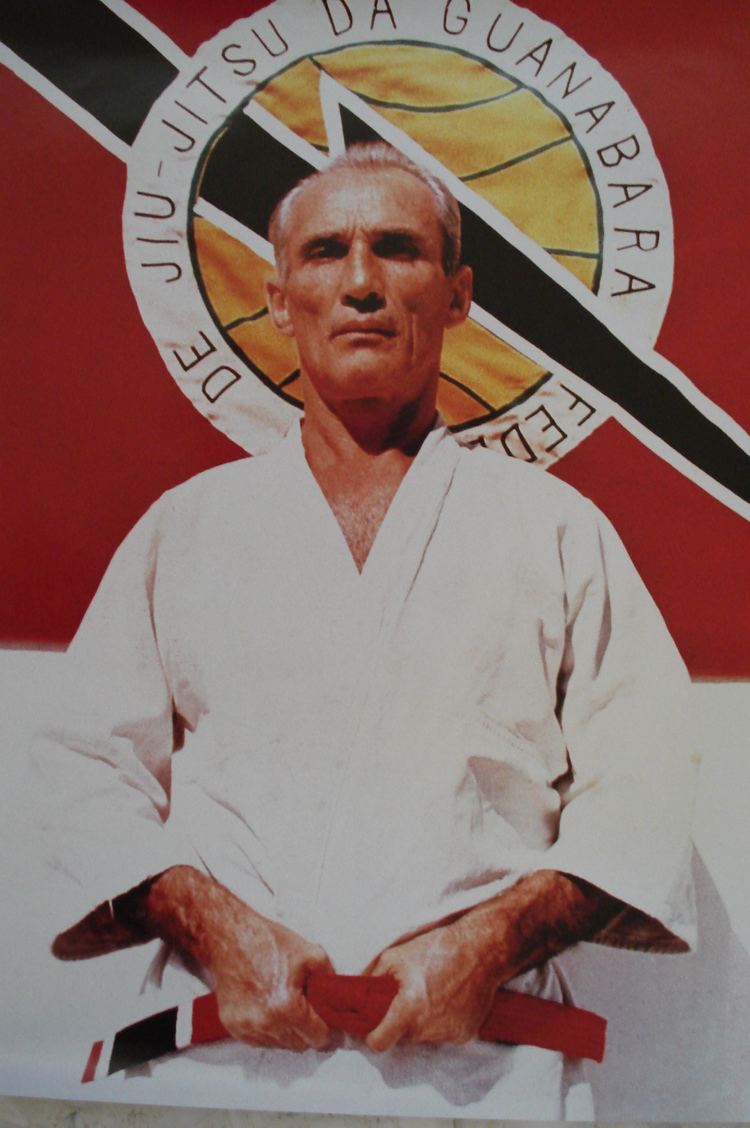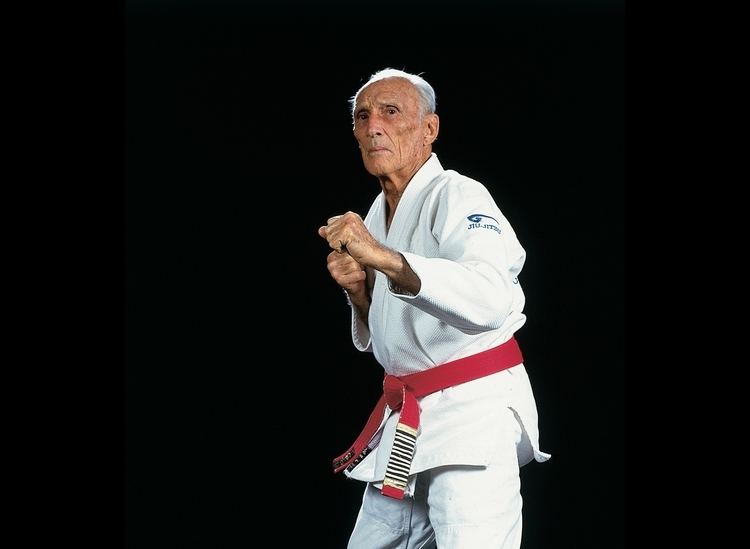Weight 65 kg Role Martial Artist | Name Helio Gracie | |
 | ||
Rank 10th degree red belt in Gracie Jiu-Jitsu6th degree black belt in Judo Notable students Children Rickson Gracie, Royce Gracie, Rorion Gracie Siblings Carlos Gracie, Mary Gracie, Oswaldo Gracie, George Gracie, Helena Gracie, Ilka Gracie, Gastao Gracie, Jr. Nephews Rolls Gracie, Carlos Gracie - Jr, Carlson Gracie, Robson Gracie, Reyson Gracie Similar People | ||
Tlc top 10 martial arts tv show rickson and helio gracie sharing knowledge and wisdom
Hélio Gracie ([ˈɛlju ˈɡɾejsi]; October 1, 1913 – January 29, 2009) was a Brazilian martial artist who, together with his brother Carlos Gracie, founded the martial art of Gracie jiu-jitsu and with Luiz França and Oswaldo Fadda the martial art of Brazilian jiu-jitsu (BJJ). According to Rorion Gracie, his father Hélio is one of the first sports heroes in Brazilian history; he was named Man of the Year in 1997 by the American martial arts publication Black Belt magazine. A patriarch of the Gracie family, he was the father of Rickson, Royler, Royce, Relson, and Ultimate Fighting Championship (UFC) co-founder Rorion Gracie, among other sons and daughters. According to one of his most notable opponents, Masahiko Kimura, Gracie held the rank of 6th dan in judo.
Contents
- Tlc top 10 martial arts tv show rickson and helio gracie sharing knowledge and wisdom
- Jud vs jiu jitsu kimura vs helio gracie 1951 x
- Early life
- Fighting career
- Kimura vs Gracie
- Later life
- Personal life
- Awards and accolades
- H lio gracie documentary subtitles biography channel
- References

Jud vs jiu jitsu kimura vs helio gracie 1951 x
Early life

Gracie was born on October 1, 1913, in Belém do Pará, Brazil. A very athletic boy, he trained in rowing and swimming from his childhood, and had his first contact in martial arts at 16, when he started training judo (at that time commonly referred to as "Kano Jiu-jitsu" or simply "Jiu-Jitsu"), with his brothers Carlos and George. He also learned catch wrestling under the renowned Orlando Americo "Dudú" da Silva, who also taught his brothers for a time. When he was 16 years old, he found the opportunity to teach a judo class and this experience led him to develop Gracie Jiu-Jitsu. A director of the Bank of Brazil, Mario Brandt, arrived for a private class at the original Gracie Academy in Rio de Janeiro, as scheduled. The instructor, Carlos Gracie, was running late and was not present. Helio offered to begin the class with the man. When the tardy Carlos arrived offering his apologies, the student assured him it was no problem, and actually requested that he be allowed to continue learning with Helio Gracie instead. Carlos agreed to this and Helio Gracie became an instructor.

Gracie realized, however, that even though he knew the techniques theoretically, the moves were much harder to execute. Consequently, he began adapting Maeda's brand of judo, already heavily based around newaza ground fighting techniques, for his particular physical attributes. From these experiments, Gracie Jiu-Jitsu was created. Like its parent style of Judo, these techniques allowed smaller and weaker practitioners the capability to defend themselves and even defeat much larger opponents. “Carlos and Helio Gracie . . . brought a fresh eye to jujitsu just as their fellow countryman brought a special new approach to football.”
Fighting career

Gracie had 20 professional fights in his career. He had 10 wins with 8 draws and two losses. He began his fighting career when he submitted professional boxer Antonio Portugal in 30 seconds in 1932. In that same year, he fought American professional wrestler Fred Ebert for fourteen 3 minute rounds. The event was claimed to have been stopped because Brazilian law did not allow any public events to continue after 2:00 AM, but in an interview Gracie admitted that he was stopped by the doctor due to the high fever caused by a swelling, and he had to undergo an urgent operation the next day.

In 1934, Gracie fought Polish professional wrestler Wladek Zbyszko, who was billed as a former world champion, for three 10-minute rounds. Even though the wrestler was almost twice Gracie's weight, he could not defeat him, and the match ended in a draw. Gracie then defeated Taro Miyake, a Japanese professional wrestler and judoka (practitioner of judo) who had an extensive professional fighting record and worked for Ed "Strangler" Lewis in the United States of America.

Gracie also fought several Japanese judoka under submission rules. In 1932, he fought Japanese judoka Namiki. The fight ended in a draw although Hélio was already twisting his arm when the bell rang. He defeated the Japanese heavyweight judoka and sumo wrestler Massagoishi via armlock. Gracie had two fights with Yasuichi Ono after Ono choked out Jorge Gracie (Hélio Gracie's brother) in a match. Both fights ended in a draw. Gracie fought judoka Yukio Kato twice. The first time was at Maracanã stadium and they went to a draw. Afterwards, Kato asked for a rematch. The rematch was held at Ibirapuera Stadium in São Paulo and Gracie winning a controversial victory by front choke from the guard.

In May 1955, at the YMCA in Rio de Janeiro, Gracie participated in a 3-hour 42 minute fight against his former student Valdemar Santana with Santana knocking out Gracie with a soccer kick. This would be the last of Helio's matches that involved striking (i.e. Vale Tudo)
Kimura vs. Gracie
Gracie issued a challenge to a highly touted Judoka named Kimura. An agreement was made under what would be known as the "Gracie Rules" via the Gracie Challenge that throws and pins would NOT count towards victory only submission or loss of consciousness. This played against Judo rules in which Pins and throws can award someone a victory.
In 1951, famous judoka Masahiko Kimura defeated Gracie in a submission judo/jiujitsu match held in Brazil. During the fight Kimura threw Gracie repeatedly with Ippon Seoinage (one arm shoulder throw), Ouchi Gari (major inner reap), Uchimata (inner thigh throw), Harai Goshi (sweeping hip throw), and Osoto Gari (major outer reap). However, Helio Gracie was able to perform ukemi, as demonstrated by his earlier match with Kimura's fellow judoka Yukio Kato, was in excellent condition, benefited from the soft mat used in competition, and showed a strong will to win and refusal to lose - he was undeterred. Unable to subdue Helio through throwing alone, the fight progressed into groundwork. Kimura maintained a dominance in the fight at this point by using techniques such as kuzure-kamishiho-gatame (modified upper four corner hold), kesa-gatame (scarf hold), and sankaku-jime (triangle choke). Thirteen minutes into the bout Kimura positioned himself to apply a reverse ude-garami (arm entanglement, a shoulderlock). Gracie refused to submit.
In a 1994 interview with Yoshinori Nishi, Gracie admitted that he had been rendered unconscious very early in the bout by a choke although Kimura released the choke and continued the bout.
As a tribute to Kimura's victory, the reverse ude-garami technique he used to defeat Gracie, has since been commonly referred to as the Kimura lock, or simply the Kimura, in Brazilian Jiu-Jitsu and, more recently, mixed martial arts circles.
Later life
Gracie's son, Rorion Gracie, was the first Gracie family member to bring Gracie Jiu-Jitsu to the United States of America. Royce Gracie, Rorion's younger brother, went on to become the first UFC champion in the organization's history; Helio coached Royce from outside the cage at UFC 1 and UFC 2.
Gracie died on the morning of January 29, 2009, in his sleep in Itaipava, in the city of Petrópolis, Rio de Janeiro. The cause of death, reported by the family, was natural causes. His last words were: "I created a flag from the sport’s dignity. I oversee the name of my family with affection, steady nerves and blood." Gracie was able to utilize the same Jiu-Jitsu techniques which he helped to develop until his death. He was 95 years old, and was teaching/training on the mat until 10 days before his death, when he became ill.
Personal life
Hélio Gracie had been married to Margarida for fifty years. During their marriage, Gracie became the father of three sons (Rickson, Rorion, and Relson) with Isabel 'Belinha' Soares and four sons (Royler, Rolker, Royce, Robin), two daughters (Rerika and Ricci) with Vera. After Margarida's death, he married Vera who was 32 years his junior. Gracie was grandfather to many BJJ black belts, including Ryron, Rener, Ralek, Kron, and Rhalan.
In his late years, Gracie was quoted as saying: "I never loved any woman because love is a weakness, and I don’t have weaknesses."
